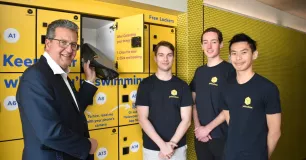
As part of Infrastructure Week (May 10 2021) the Smart Cities Council produced, a joint session with Readiness Challenge Winners Nashville, TN and Orange County, FL, on how communities can use community-scale data to bolster their economic, social, and environmental resilience. Cutting edge solutions that help communities use data to meet these needs will also be presented by Neighbourlytics, State of Place, and Xylem.
Speakers included:
- Dr. Christine Boyle from Xylem. See this explanation of Xylem's Water Equity Lens.
- Dr. Mariela Alfonso from State of Place. See presentation below.
- Lucinda Hartley from Neighbourlytics. See presentation below.
Roundtable participants -
- Philip Bane, Managing Director Smart Cities Council
- Jeff Benavides, Chief Sustainability and Resilience Office of Orange County
- Faye DiMassimo, Chief Advisor to Mayor John Cooper of Nashville,
- Dr. Janey Camp, Associate Director of Vanderbilt Engineering Center for Transportation and Operational Resiliency (VECTOR)
- Tom Palko, Assistant Director, Metro Nashville Water Services
- Roger Lindsey, Floodplain Manager / Stormwater Design Review at Metro Nashville Water Services,
- Jennifer Higgs, Nashville Information Technology Services
Overview: The Smart Cities Council’s in-depth community work has revealed that cities are increasingly interested in using data about places and people to make communities livable, workable, and sustainable. COVID’s impact across all aspects of quality of life has only served to accelerate cities’ need to make their communities more resilient to inevitable future shocks and stresses – not just from a health perspective, but also environmentally, socially, and economically. The Resilient Cities Network (‘RCN,’) defines
- “Shocks’ as typically single-event disasters such as fires, earthquakes, and floods.
- “Stresses” as factors that pressure a city on a daily or reoccurring basis, such as chronic food or water shortage, an overtaxed transportation system, endemic violence, or high unemployment.
- “Resilience” as about making <communities> better, in both good times and bad, for the benefit of all its citizens, particularly the poor and vulnerable.
Communities like Nashville, Tennessee and Orange County, Florida are considering how shocks and stresses impact their communities and how they can become more resilient. Both cities are also determined to ‘bounce-back better’ from the COVID 19 pandemic impacts on their economies, especially given both are destinations for culture and entertainment. The Smart Cities Council is managing Readiness Programs for both cities, where the focus is:
- Urban flooding. The driver for Nashville is the mitigation of the impact of urban flooding on vulnerable populations.
- Climate impacts. The driver for Orange County is making its built environment more sustainable and resilient so as to mitigate the impact of increased temperatures caused by climate warming.
This session, part of a multi-part program for each city, will explore what strategies, policies, and tools Nashville and Orange County can implement to increase their communities’ resilience to shocks and stresses, especially as it concerns Covid 19, urban flooding, and climate change. Additionally, the session will address how bolstering resilience can lead to improved social, health, environmental, and economic benefits for communities.
Finally, the session will also showcase how private sector innovations and solutions can strengthen community resilience, across the quadruple bottom line.
For example –
- Neighbourlytics is an urban analytics platform who have developed an approach that provides ‘hyper-local’ insights into urban life - everyday activities that happen within and between buildings - which helps city makers understand the human experience of neighbourhoods and prioritise decisions and investment based on local strengths and needs
- State of Place’s software helps city-makers use built environment data and predictive analytics to make more effective, cost-efficient, and transparent decisions that optimize social, health, environmental, and economic value, which lead to more livable, equitable, and sustainable places.
- Xylem provides a spatially-explicit web-based app that maps the Water Equity Pillars of: 1) Access, 2) Benefits, and 3) Resilience by census tract. Utilities can use the Lens to understand their water equity performance, according to benchmarks developed per equity pillar and across their communities.
Deeper Dive - A growing focus on people
- To date, a focus on things. Cities and solution providers have mostly focused on things, buildings, transport, resources like energy and water – all as collected, communicated and analyzed. The goal was that by measuring time-series data and correlating it to primarily economic outcomes (usage, cost and income/revenge for example) a city could improve the human experience and make the city livable, workable and sustainable.
- Environmental data. In the past fifty years, there has also been an effort to measure environmental outcomes as measured by carbon emissions and overall pollution of air and water correlating this to impact on the environment, our economies and human health. Generally, this has been accomplished through an Internet of Things architecture with a growing focus on how 5G will communicate that data. These are valid approaches given the state of our technology; but the nascent ability to measure human experience itself gives us new opportunities.
- Acceleration to make this about people. Just as COVID has accelerated existing trends, it has accelerated an interest in finding ethical ways to measure and positively affect the ‘human experience’ of a city. Sentiment analysis was an early approach to this, though it has flaws. The Smart Cities Council has worked with other organizations that have looked at analysis of social and digital media with sophisticated algorithms to measure human responses, such as emotion.
- Companies such as Neighbourlytics, are now also anchoring emotions to a location for a richer picture of a community life.
- State of Place focuses on measuring the built environment factors that impact quality of life outcomes and value across the quadruple bottom line (social, health, environmental, and economic) AND creating forecasting models that help us understand which types of changes to the built environment are most likely to lead to desired outcomes as well as actual estimate how proposed changes to the built environment will indeed lead to specific outcomes, including the lowering the likelihood of vehicle collisions, mitigation of heat waves and floods, decreases to chronic diseases and Covid 19, reducing vehicle miles traveled and GHGs, and cutting crime rates, among other factors. The premise is that you cannot simply collect data on existing environmental, health, social, or other measures of “performance” – that simply quantifies the problem. You must also both measure and understand the factors that actually impact that performance – so that you can identify what changes to the inputs will have the biggest impact on the “performance” metrics you want to improve or mitigate.
- Xylem is working to solve a problem of a lack of visibility, within a city, of how water-related programs and investments are distributed across the service area, according to equity criteria. A common refrain from community advocacy groups is that poorer areas of the city have lower service levels. Many utility leaders also say that they lack an empirical basis to measure how they are doing on water equity performance and lack data to understand how their programs and investments differentially impact people and communities.
Throughout this process, Nashville and Orange County are seeking to measure, analyze and change the ‘human experience’ of disasters, both immediate (‘shock’) like floods and fires and systematic (‘stressors’) like racism or poverty.



